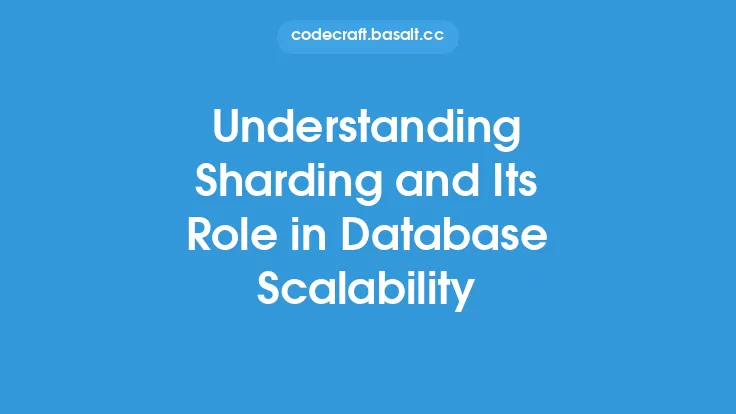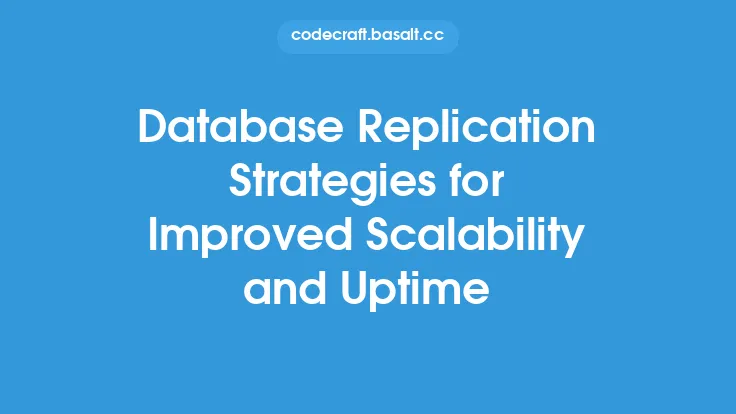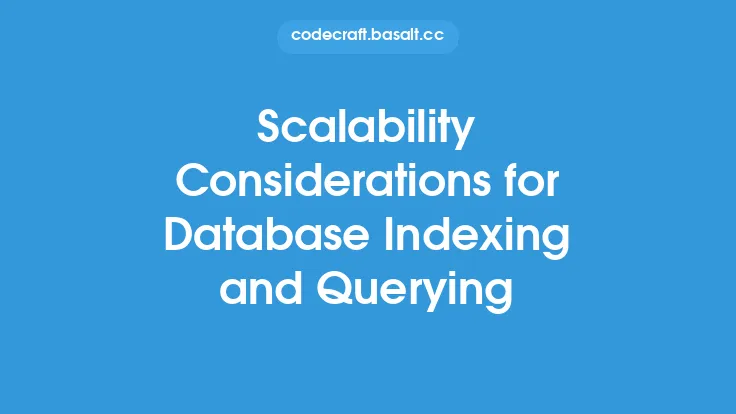As the amount of data being generated and stored continues to grow exponentially, the need for scalable database systems has become increasingly important. NoSQL databases, in particular, have gained popularity in recent years due to their ability to handle large amounts of unstructured and semi-structured data. However, as the size of the data grows, so does the complexity of the database, making scalability a major challenge. In this article, we will explore the challenges and opportunities of NoSQL database scalability, and discuss the various techniques and strategies that can be used to overcome these challenges.
Introduction to NoSQL Database Scalability
NoSQL databases are designed to handle large amounts of data and provide high performance, but they can become bottlenecked as the data grows. The main challenge of NoSQL database scalability is to ensure that the database can handle increasing amounts of data and user traffic without compromising performance. This requires a deep understanding of the underlying architecture of the database and the ability to design and implement scalable solutions. NoSQL databases use a variety of data models, such as key-value, document, graph, and column-family stores, each with its own strengths and weaknesses. Understanding these data models and how they impact scalability is crucial for designing and implementing scalable NoSQL databases.
Challenges of NoSQL Database Scalability
One of the main challenges of NoSQL database scalability is handling increasing amounts of data. As the data grows, the database needs to be able to store and retrieve it efficiently. This requires a scalable storage solution that can handle large amounts of data without compromising performance. Another challenge is handling increasing user traffic. As more users access the database, the database needs to be able to handle the increased load without compromising performance. This requires a scalable architecture that can handle large amounts of concurrent requests. Additionally, NoSQL databases often require complex queries and indexing, which can impact performance and scalability. Ensuring that the database can handle complex queries and indexing without compromising performance is a major challenge.
Opportunities of NoSQL Database Scalability
Despite the challenges, there are many opportunities for NoSQL database scalability. One of the main opportunities is the ability to handle large amounts of unstructured and semi-structured data. NoSQL databases are designed to handle this type of data, and they provide a flexible and scalable solution for storing and retrieving it. Another opportunity is the ability to provide high performance and low latency. NoSQL databases are designed to provide high performance and low latency, making them ideal for real-time web applications. Additionally, NoSQL databases provide a flexible and scalable architecture that can be easily extended and modified as the needs of the application change. This makes them ideal for applications that require a high degree of flexibility and scalability.
Techniques for Achieving NoSQL Database Scalability
There are several techniques that can be used to achieve NoSQL database scalability. One of the main techniques is data partitioning, which involves dividing the data into smaller pieces and storing them across multiple nodes. This allows the database to handle large amounts of data and provides a scalable solution for storing and retrieving it. Another technique is data replication, which involves duplicating the data across multiple nodes to ensure that it is always available. This provides a scalable solution for handling increasing user traffic and ensures that the database is always available. Additionally, NoSQL databases can use caching and indexing to improve performance and scalability. Caching involves storing frequently accessed data in memory, while indexing involves creating a data structure that allows the database to quickly locate specific data.
Strategies for Implementing NoSQL Database Scalability
There are several strategies that can be used to implement NoSQL database scalability. One of the main strategies is to use a distributed architecture, which involves dividing the database into smaller pieces and storing them across multiple nodes. This allows the database to handle large amounts of data and provides a scalable solution for storing and retrieving it. Another strategy is to use a cloud-based solution, which involves storing the database in the cloud and providing access to it through a web interface. This provides a scalable solution for handling increasing user traffic and ensures that the database is always available. Additionally, NoSQL databases can use auto-scaling and load balancing to improve performance and scalability. Auto-scaling involves automatically adding or removing nodes as the needs of the application change, while load balancing involves distributing the load across multiple nodes to ensure that no single node becomes overwhelmed.
Best Practices for NoSQL Database Scalability
There are several best practices that can be used to ensure NoSQL database scalability. One of the main best practices is to monitor the database regularly, which involves tracking performance and scalability metrics to ensure that the database is operating within optimal parameters. Another best practice is to use a scalable data model, which involves designing the data model to handle large amounts of data and provide high performance. Additionally, NoSQL databases should be designed to handle failures and provide high availability. This involves using techniques such as data replication and caching to ensure that the database is always available. Finally, NoSQL databases should be designed to provide security and compliance, which involves using techniques such as encryption and access control to ensure that the data is protected.
Conclusion
NoSQL database scalability is a complex and challenging topic, but it also provides many opportunities for improving performance and scalability. By understanding the challenges and opportunities of NoSQL database scalability, and by using techniques such as data partitioning, data replication, caching, and indexing, it is possible to design and implement scalable NoSQL databases that can handle large amounts of data and provide high performance. Additionally, by using strategies such as distributed architecture, cloud-based solutions, auto-scaling, and load balancing, it is possible to implement scalable NoSQL databases that can handle increasing user traffic and provide high availability. By following best practices such as monitoring, using scalable data models, handling failures, and providing security and compliance, it is possible to ensure that NoSQL databases are scalable, performant, and reliable.





